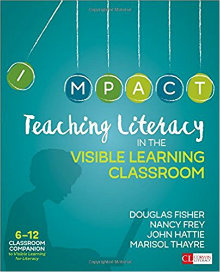Visible Learning Tools to Teach Literacy Effectively
Impact: Teaching Literacy in the Visible Learning Classroom, Grades 6 – 12
By Douglas Fisher, Nancy Frey, John Hattie, and Marisol Thayre
(Corwin, 2017 – Learn more)
 Reviewed by Kathee Lamberies
Reviewed by Kathee Lamberies
I selected Teaching Literacy in the Visible Classroom to review because I was interested in a book that offered strategies and tools that have a high impact on learning.
Our principal always tells us the Hattie effect size of strategies she offers, so when I saw that John Hattie was one of the authors of this book, I knew this would be a great fit for me.
Teaching Literacy in the Visible Classroom offers the following seven chapters:
- Mobilizing Visible Learning for Literacy
- Teacher Clarity
- Deliberate and Direct Teaching
- Teacher-Led Dialogic Instruction
- Student-Led Dialogic Instruction
- Independent Learning
- Tools to Use in Determining Literacy Impact
 The book also offers a list of 21 videos that the reader can access, along with the QR code, and there’s a website if you do not have the QR app.
The book also offers a list of 21 videos that the reader can access, along with the QR code, and there’s a website if you do not have the QR app.
Reading this book was enlightening and inspiring. It gave me such great “AHA” moments and made me excited to try the strategies that were given. Actual lesson plans from teachers are included, as well as classroom experiences using the tools.
I found “Chapter 5: Student-led Dialogic Learning” to be exceptionally informative. As I was reading the strategies mentioned, I could visualize where I could use these activities in my classroom. I used the “Gallery Walk” adopted to my learning target, and it was a success with the students. They enjoyed the process and could apply the learning target in an organic manner.
Teaching Learning in the Visible Classroom advocates the dialogic (“in the form of dialog”) classroom, where ideas are exchanged with valid claims to back them up. The use of the “Pinwheel” discussion to prepare students for using the “Fishbowl” discussion forum was helpful for 6th graders.
Other tools that are highlighted in this book are sentence stems for accountable talk, a template for a “Conversation Roundtable” discussion, and recommendations for rules for discussion and conversation. Reciprocal Teaching is included in Chapter 5 as well with a sample template.
Chapter 6 focuses on Independent Learning and offers ideas such as reading fluency, independent writing, including power writing, and the benefits of building writing fluency. The authors also offer advice for giving students feedback on their writing without overwhelming them. The authors say to take error patterns from your class and use modeling as well as direct instruction using student work (with names removed, of course!).
The advice from the authors in Chapter 6 includes a “Teaching Takeaway.” Teachers should ask themselves three questions when assigning tasks or activities: “Does it promote metacognition? Does it promote goal setting? Does it promote self-regulation?” Great advice to design activities that will be tailored to the learning target, yet relevant to students.
Bang for your buck
Each strategy/tool that is offered in the book comes with the Effect Size on the side, so teachers know which strategies give you the most “bang for your buck.”
The book also contains a Compendium of Assessments. This gives sample assessments, as well as explanations and a meta-comprehension student form, with administration and scoring directions. An appendix is included that lists all of the strategies with their Effect Size.
I cannot recommend this book enough to teachers of grades 6-12. I know I will be using this and tabbing pages for years to come. It is likely to become my new “bible” of teaching!
Kathee Lamberies is in her 14th year of teaching. Currently, she teaches sixth grade English and Social Studies. She has taught first, second, fourth and fifth grades in prior years. She has a Bachelor’s and a Master’s from Grand Valley State University.


































Kathee, your enthusiastic endorsement of this book makes me want to buy and read it! Thanks for the review.